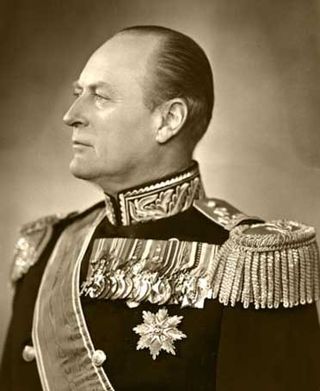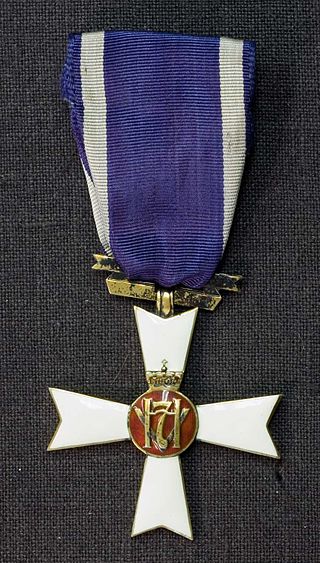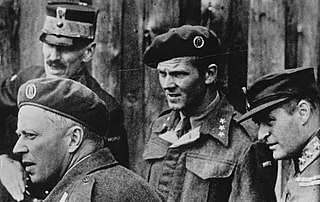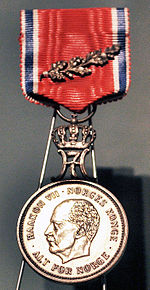
Haakon VII was King of Norway from November 1905 until his death in September 1957.

Olav V was King of Norway from 1957 until his death in 1991.

Harald V is King of Norway. He succeeded to the throne on 17 January 1991.

Haakon, Crown Prince of Norway is the heir apparent to the Norwegian throne. He is the only son of King Harald V and Queen Sonja.

Hans Majestet Kongens Garde (HMKG) (lit., His Majesty The King's Guard; the Royal Guards) is a battalion of the Norwegian Army. The battalion has two main roles; it serves as the Norwegian King's bodyguards, guarding the royal residences (the Royal Palace in Oslo, Bygdøy Kongsgård and Skaugum) and Akershus Fortress in Oslo, and is also the main infantry unit responsible for the defence of Oslo. The HMKG is located in Huseby leir in Oslo. Huseby leir is located on the old Oslo farm Nordre Huseby gård (Northern Huseby farm), which was acquired by the Norwegian government in the late 19th century.

Erling Sven Lorentzen was a Norwegian-Brazilian shipowner and industrialist. He founded Aracruz Celulose in 1968. He was the widower of Princess Ragnhild, the eldest child of King Olav V of Norway. In addition to being a Norwegian princess, his wife was in the line of succession to the British throne and occupied the 18th place at the time of her birth. Erling Lorentzen was a member of the Lorentzen family of shipping magnates.

The Royal Norwegian Order of Saint Olav is a Norwegian order of chivalry instituted by King Oscar I on 21 August 1847. It is named after King Olav II, known to posterity as St. Olav.

HNoMY Norge is the Royal Yacht of the King of Norway. One of only three remaining Royal Yachts in Europe, the ship's name Norge is Norwegian Bokmål for Norway. The Royal Yacht Norge was the Norwegian people's gift to King Haakon VII in 1947. The yacht is owned by the King but maintained and crewed by the Royal Norwegian Navy. Originally built in 1937 in the United Kingdom for Thomas Sopwith, she served in the Royal Navy as an armed yacht during the Second World War.

This is a list of Norwegian orders and medals, in order of precedence. This list contains all medals approved for wearing on a Norwegian military uniform in ranked order.

King Haakon VII's Freedom Cross was established in Norway on 18 May 1945. The medal is awarded to Norwegian or foreign military or civilian personnel for outstanding achievement in wartime. It is ranked fifth in the order of precedence in the Norwegian honours system.

The War Medal is a Norwegian war decoration for service during Second World War, and later for meritous service during war.

Jens-Anton Poulsson DSO, was a Norwegian military officer. During World War II he was a Norwegian resistance member, especially noted for his role in the heavy water sabotage 1942–1943. He continued his military career after the war, and was appointed colonel in 1968.
Ragnar Leif Ulstein MM was a Norwegian journalist, writer and resistance member. He wrote several documentary books from the Second World War, including surveys of the SOE group Norwegian Independent Company 1, volunteers sailing from Norway to Scotland, refugee traffic from Norway to Sweden, and military intelligence in Norway.

King Haakon VII's Medal of Liberty was established on 18 May 1945. The medal is awarded to Norwegian or foreign military or civilian personnel for significant service to Norway during World War II. This service need not have been in direct contact with the enemy.
Skule Valentin Storheill was a Norwegian naval officer who reached prominence in World War II while serving aboard Norwegian warships within the Royal Navy, and received Norway's highest military decoration, the War Cross with Sword.

Harald Sandvik was a Norwegian military officer and sports administrator. He is best known as commander of the SOE branch Kompani Linge from 1943 to 1944 and chief of the Norwegian Defence Sports Council from 1955 to 1971.
Birger Edvin Martin Strømsheim, was a Norwegian resistance member during World War II, especially noted for his role in the heavy water sabotage 1942–1943.
The King Haakon VII 1905–1955 Jubilee Medal, also known as the King's Jubilee Medal, is a Norwegian award instituted in November 1955 by Haakon VII of Norway in honor of the 50th anniversary of his accession to the throne. The medal ranks 32nd in the Norwegian decoration order of precedence.
The Royal House Centennial Medal is a Norwegian award established by Harald V of Norway to commemorate the centennial of the Norwegian Royal Family. The day that it was established marks the hundredth anniversary of the day that Haakon VII arrived in Norway: November 25, 1905. The medal ranks 29th in the Norwegian decoration order of precedence.

The South Pole Medal or Medal Commemorating the 1910–1911 Fram Expedition to the South Pole is a Norwegian medal established by Haakon VII of Norway on August 20, 1912 to recognize participants in Roald Amundsen's South Pole expedition. The medal was awarded to participants in the exhibition on the day it was instituted. The medal was designed by the engraver Ivar Throndsen.















